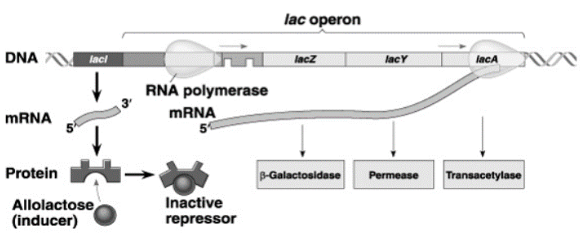The cellular environment has an impact on cellular function. Adaptation to specific environments is accomplished by controlling the expression of genes that code for the enzymes and proteins essential for survival in a very specific environment. Nutrients, temperature, light, poisons, metals, chemicals, and messages from alternate cells are all factors which influence organic phenomena. Human illnesses and diseases are caused by malfunctions in the management of organic phenomena.
Regulation Gene Expression
Gene expression regulation refers to the cell’s utilisation of a variety of processes to raise or decrease the output of a certain gene product (an RNA or a protein).
Steps of Regulation Gene Expression
Replication Level
At the replication level, mutations which occur during the DNA replication might affect gene expression.
Transcriptional Level
Repressors and activators can influence the transcription of a specific gene at the transcriptional level.
Post-Transcriptional Level
Gene expression is achieved at the post-transcriptional level through post-transcriptional changes like RNA splicing.
Translational Level
RNA interference mechanism, for example, can influence the translation of an mRNA molecule at the translational level.
Post-Translational Level
By manipulating post-translational modifications, the production of a protein can be controlled at the post-translational level.
In prokaryotes, however, gene expression regulation occurs primarily during transcription initiation. It includes activators that regulate gene expression positively and repressors that regulate gene expression negatively.
Lac Operon
E. coli’s lactose operon produces the b-galactosidase protein, which hydrolyses milk sugar into the saccharose & aldohexose.
The DNA of an animal product has three cistrons, or deoxyribonucleic acid fragments, each of which codes for a specific macromolecule. Cistrons encode proteins that can operate on their own or as subunits of bigger enzymes or the structural proteins.
b-galactosidase is encoded by the Z gene. The Y gene genes for a permease that aids lactose uptake into the bacteria. The A gene encodes the Thiogalactoside Transacetylase with little known function. All three of the genes are transcribed as a single polycistronic mRNA. Multiple genetic messages are contained in polycistronic RNA, each having its own journey initiation & termination signals.
Lac Operon Regulation Gene Expression
Two distinct proteins regulate the activity of promoter which governs the expression of animal product DNA. One protein hinders RNA enzyme from the transcribing (negative control), while the other promotes the RNA enzyme’s attachment to promoter (positive control).

Inducible operons, where different types of proteins bind, regulate gene expression in the prokaryotic genes by either activating or inhibiting the transcription of the operon depending on the cell’s needs. The Lac operon is a reversible one. It enables the use of lactose (a disaccharide) in energy generation by converting it to glucose, which can then be used in cellular respiration when glucose is not readily accessible. The lac operon is turned on and off depending on whether or not there is glucose in the cell. The lac repressor is in charge of the lac operon’s ‘turn off’ mode, while CAP is in charge of the lac operon’s ‘turn on’ mode.
Positive Control of Lac Operon
Although milk sugar causes animal product DNA to be expressed, the level of expression is relatively low. The explanation for this could be that the DNA of animal products is prone to catabolite suppression, or reduced gene expression caused by growth in the presence of the aldohexose. Because glucose is so easily digested that it is the preferred fuel source over milk sugar, it is prudent to stop the expression of the animal product DNA when aldohexose is given.
Negative Control of Lac Operon
A tetramer with four identical subunits known as animal product agent could be the macromolecule that suppresses transcription of animal product DNA. The lacI factor, which is situated upstream of lac operon & has its own promoter, encodes the animal product agent. The expression of animal product factor is uncontrolled, and extremely low quantities of the lac agent are produced indefinitely.
In the absence of milk sugar, the animal product agent binds to deoxyribonucleic acid at a website termed the operator, which is downstream of promoter & upstream of transcriptional initiation site, to prevent the expression of the animal product DNA. The operator is made up of a specific ester sequence that the agent recognises and binds to extremely firmly, physically inhibiting (strangling) transcription initiation.
Lac Repressor
The lac repressor is a lactose sensor that prevents the lac operon from being transcribed in the presence of glucose. When compared to lactose, the use of glucose in cellular respiration needs fewer stages in the energy production process. As a result, when glucose is present in the cell, it is quickly broken down to produce energy in the cellular pathways. Furthermore, when glucose is employed in respiration, the use of lactose for the earlier purpose must be prevented in order to maximise cellular respiration efficiency. The binding of the lac repressor to the lac operon’s operator region blocks the lac operon’s transcription in this condition.
Conclusion
The lac operon is an inducible operon that contains clusters of genes that encode proteins essential for lactose metabolism. As a result of the lac operon’s transcription, a Polycistronic mRNA molecule which is capable of synthesising several gene products is produced. For cellular respiration, the lac operon is only expressed in the absence of glucose and in the presence of lactose within the cell. When glucose is abundantly accessible but lactose is not, lac repressor binds to the operator region of lac operon.
 Profile
Profile Settings
Settings Refer your friends
Refer your friends Sign out
Sign out






